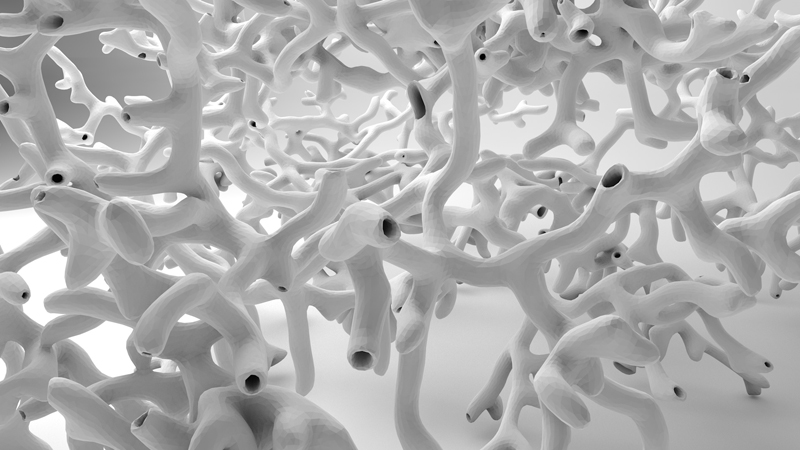
The Meeting Point

Scholars have frequently suggested that art and science find their meeting point in method, and that idea could be the tagline for the Interrogating Methodologies symposium taking place at UC Santa Barbara on April 18 and 19. The symposium explores boundaries in art and science and seeks to initiate conversation among specialists from the sciences, social sciences, humanities and arts, all of whom grapple with questions about how those communities intersect.
“We wanted to create a situation where we have conversations between scientists and artists and to focus in on methodology,” said George Legrady, director of the Experimental Visualization Lab and chair of the Department of Media Arts and Technology. “How does one create research? How does one proceed toward discovery?”
The goal of the day-and-a-half-long symposium is to stimulate conceptual development for a 2016 exhibition at the UC Santa Barbara Museum of Art to be curated by Legrady and John Weber, founding director of the Institute of the Arts and Sciences at UC Santa Cruz. The novel exhibition, “Vision and Wave,” will explore the engaging ways in which scientists pursue research.
“We intend to throw open the laboratory door for discussion and debate — and for aesthetic inspiration,” said Legrady. “The symposium offers a form of outreach, hybridization and integration of the public through feedback contribution. It consists of presentations and dialogues aimed at sharing research experiences between invited peers, but with a broader audience in mind for the exhibition itself.”
The multidisciplinary symposium will begin at 9 a.m. Friday, April 18, in the McCune Conference Room, 6020 Humanities and Social Science Building, and will feature six panels covering a wide range of topics from big data to citizen science — scientific research conducted in whole or in part by amateur or nonprofessional scientists.
“Scientists and artists will present case studies about how breakthroughs occurred in their work,” Legrady explained. “Speakers will examine assumptions and triggers, retrace how their thinking evolved and recount how insights emerged,” said Weber.
After a brief introduction, James Elkins will deliver the keynote address, “Problems in the Theory of Visualization.” Elkins, the E.C. Chadbourne Chair in the Department of Art History, Theory, and Criticism at the School of the Art Institute of Chicago, will discuss his analysis of scientific visualization with examples from a conference he co-organized that takes place this month in Berlin.
The first panel, "The Big Picture: How to Visualize Big Data," features Joel R. Primack, director of the UC systemwide High-Performance Astro-Computing Center and a professor of physics at UC Santa Cruz; Keith Clarke, co-director of the Spatiotemporal Innovation Center and a professor of geography; and B.S. Manjunath, director of the Center for Bio-Image Informatics and a professor in the Department of Electrical and Computer Engineering.
James K. Gimzewski, a nanotechnology scientist from UCLA who was featured recently in the Los Angeles Times for the development of a chip that could lead to a thinking machine, will discuss art and science in the evolution of intelligence, as part of the “Interrogating the Methodologies of Art & Science” panel. Lina Nilsson, the innovation director of UC Berkeley’s Blum Center, will participate on the “Citizen Science: How Does the Public Contribute to Science?” panel; and M. Paz Gutierrez, an assistant professor of architecture at UC Berkeley’s School of Environmental Design and a specialist in nature and multifunctional material organizations, will sit on the “Asking the Right Questions, Avoiding the Wrong Ones; How Research Evolves” panel.
Amy Heibel, associate vice president for technology and digital media at the Los Angeles County Museum of Art, and Jill Scott, director of the Swiss artists-in-labs program, will contribute to the “Inviting Artists Into the Lab and Science Into the Museum” panel, moderated by Weber. The third panelist is Enrico Ramirez-Ruiz, professor of astronomy and astrophysics at UC Santa Cruz, who cites as his inspiration “The Library of Babel,” a short story by the Argentinian writer Jorge Luis Borges.
“We seek to understand more thoroughly how process informs outcomes and to develop new ways to meet the challenge of how to feature and represent a scientific research process in the museum as an installation,” Legrady concluded.
Free and open to the public, the symposium is sponsored by the Center for Nanotechnology in Society; Art, Design & Architecture Museum; and Media Arts & Technology Program. It is co-sponsored by the Institute of the Arts & Sciences at UC Santa Cruz.
More information, including a complete schedule and program, can be found at www.interrogating-methodologies.org.



